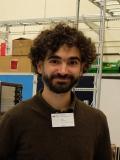Anton Khaplanov

Anton Khaplanov
Anton Khaplanov is a Detector Scientist at ESS. He is a specialist in detector technologies, currently working on thermal neutron detectors in neutron scattering science. His PhD project was in Experimental Nuclear Physics at KTH in Stockholm, and was focused on gamma-ray detectors built for nuclear spectroscopy. With advanced signal processing and analysis, Anton helped show that these detectors could enhance the resolution in spectroscopy of relativistic beams and further have applications in gamma-ray imaging. Anton’s work with neutron detectors today has other goals and applications; nevertheless, he apply many techniques, which he learned during his PhD.
- During my first 3 years of work at ESS, I was stationed at the ILL in Grenoble, France, where I worked on the development of the Multi-Grid detector within the CRISP project, in collaboration between ESS and ILL. At the end of this assignment, I returned to Sweden and joined the ESS Detector Group in Lund. I continued working on the development of neutron detectors, since September 2015 with the support of the BrightnESS grant. After a series of demonstrators with the Multi-Grid technology, we are now focusing on its applications in the ESS direct spectroscopy instruments, CSPEC and T-REX. This implies working closely with these two instrument teams in order to ensure that the detector provides the best possible performance for their requirements. My work as a neutron detection technology researcher involves conception, design, assembly and tests of detector prototypes. I very much look forward to the construction of the two final detectors.
This possibility of in-depth study of the detector has been made possible by the BrightnESS grant and, I believe, will allow us to provide the best possible solutions for the ESS instruments and for other neutron scattering research facilities. This type of development lies on the verge of academic research and technology R&D and the BrightnESS grant provides just the right environment for that. It also facilitates the exchange of knowledge and collaboration with other key European researchers.
The Multi-Grid detector is the topic of the task 4.3 of BrightnESS, titled “Large-Area Detectors”, and that is exactly the challenge with this technology. The detector has been proposed, originally at the ILL, as the solution for instruments that require around 30 meters squared of detector coverage, at a reasonable cost and with an excellent performance and signal-to-noise ratio. This combines the need for rigorous testing and deep understanding of the physical processes within the detector, while working within the restrictions imposed by material costs, efficiency of assembly and potential for mass-production.
From my point-of-view, the Multi-Grid and other detectors developed within BrightnESS will be of key importance for enabling the performance of the ESS instruments where more conventional technologies fail to meet the requirements. These include requirements due to a much greater neutron flux of the ESS and, in the case of the Multi-Grid detector, the unacceptable increase in the price of the more conventional technologies. With this, the ESS is set to become the flagship not only in the scientific output of its user community, but also in the development of instrumentation, that will be of a great value to the rest of the neutron scattering community.

 is funded by the European Union Framework Programme for Research and Innovation Horizon 2020, under grant agreement 676548.
is funded by the European Union Framework Programme for Research and Innovation Horizon 2020, under grant agreement 676548.